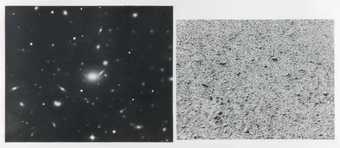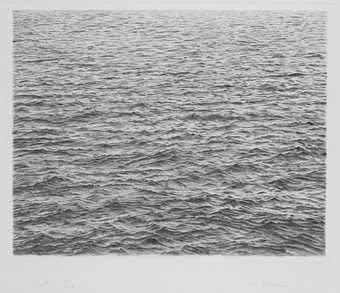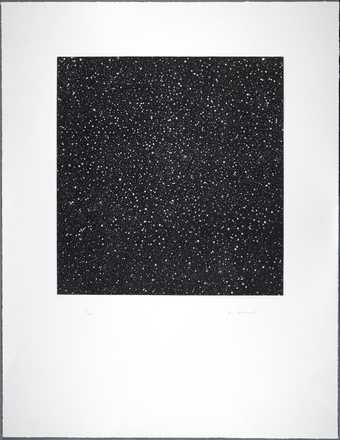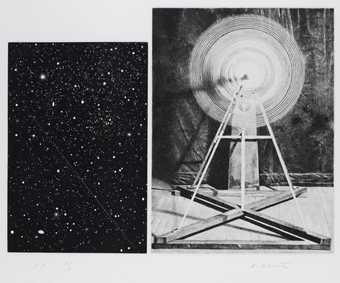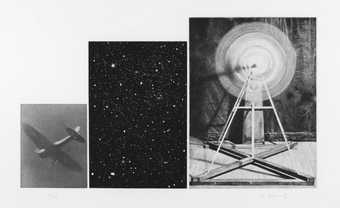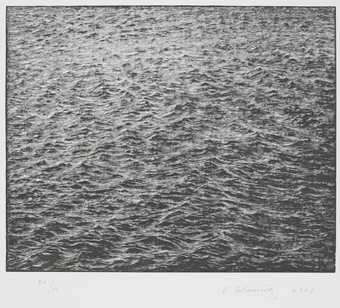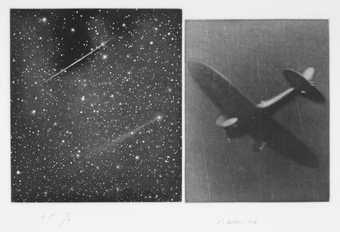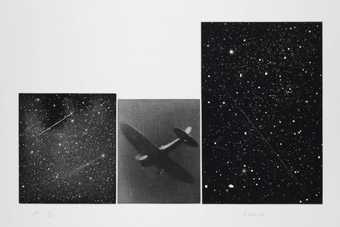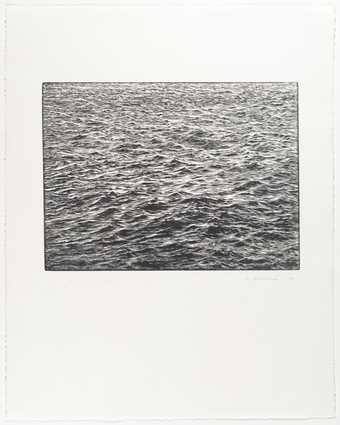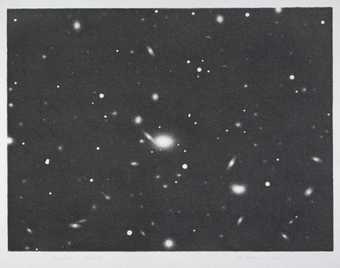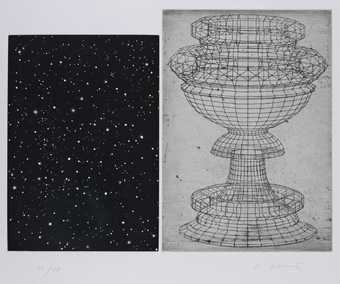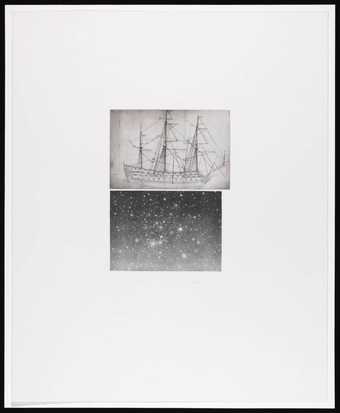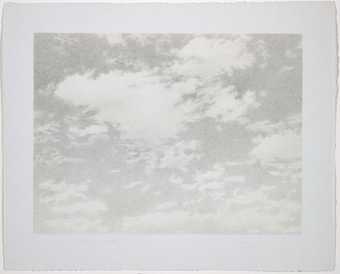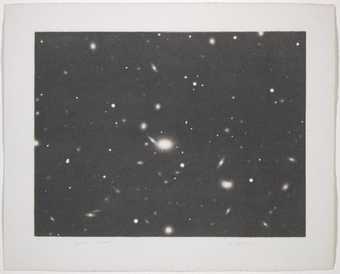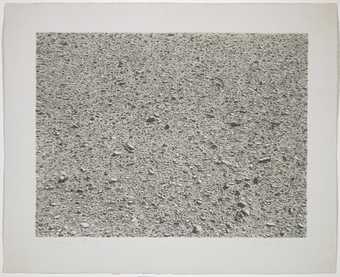
On loan
Auckland Art Gallery (Auckland, New Zealand): Light
- Artist
- Vija Celmins born 1938
- Medium
- Lithograph on paper
- Dimensions
- Frame: 473 × 566 × 21 mm
image: 317 × 420 mm
support: 420 × 512 mm - Collection
- Tate
- Acquisition
- Purchased with assistance from the American Fund for the Tate Gallery, courtesy of the Judith Rothschild Foundation 1999
- Reference
- P78336
Summary
Ocean is one of a set of four lithographs Celmins made from pencil drawings of a day sky (Sky Tate P78334), a night sky (Galaxy Tate P78335) and an area of rocky desert earth (Desert Tate P78337). The lithographs were produced in an edition of seventy-five, of which Tate’s copies are the artist’s proofs. The set was printed by the Cirrus Press, Los Angeles and published by the artist.
Celmins was born in Riga, Latvia. In 1944, fleeing the advancing Soviet army, her family settled in Germany before emigrating to the United States in 1949. She grew up in Indianapolis, where she attended the John Heron Art Institute (graduated 1962), and then moved to Venice, California where she completed a Masters Degree in Painting at the University of California in Los Angeles (1965). She relocated to New York in 1981. Influenced by the work of Jasper Johns (born 1930), Celmins’ paintings of the early 1960s feature such ordinary objects as a heater, a lamp, a fan and a television set; depicted life-size in a realistic manner, they are imbued with a sense of strangeness, latent danger and alienation through Celmins’ use of dark grey tones and empty backgrounds. In the mid to late 60s she painted disaster scenes she found in newspaper and magazine cuttings: war planes, explosions, a burning vehicle, a car riddled with bullets and a huge lorry appearing out of the night darkness. The uneasy mood in all these paintings is accentuated by the artist’s virtually exclusive use of grey. In 1968 she began drawing two-dimensional surfaces: first pictures printed on fragments of paper which she isolated in the centre of the drawing, emphasising the double layer of representation, then turning to recently released photographs of the surface of the moon (taken by the Russian satellite Lunar 9) and the ocean. Through the 1970s Celmins developed her meticulous and time-consuming technique, depicting the surface texture of areas of sea, sky and desert ground which completely fill the picture plane, unbroken by horizon, building or any form of life. In her drawings and paintings, the sea, sky or desert is usually represented at an angle, creating an impression of space and depth and filling the picture plane with an almost flat, frontal surface. She has explained:
I see drawing as thinking, evidence of getting from one place to another. One draws to define one thing from another ... I tend to take very small increments and steps in changing. An example was that I had been working with the pencil and I began to see that the graphite itself had a certain life to it. So I did a series of images of oceans and deserts using different grades of graphite and pushing each one to its limit. I learned a lot about the possibilities of expressiveness in graphite by doing this. Then I moved into the galaxy drawings. Even though you may think they came from lying under the stars, for me, they came out of loving the blackness of the pencil. It’s almost as if I was exploring the blackness of the pencil along with the image that went with it.
(Quoted in Drawing as Thinking, [pp.1-2].)
Celmins’ images are rendered with an obsessive attention to detail and in a reduced palette of grey tones that approximates them to black and white photographic reproduction. However they are about the process of drawing and its development rather than the faithful copying of a photograph. Although the subject is familiar, Celmins’ treatment of it renders it strange; viewed from a distance her drawings and paintings convey a sense of emptiness and loneliness but viewed close up, the remarkable texture of her rendition and the characteristics of the graphite, charcoal and oil paint she uses become fascinating and distracting. Each of the elemental views – the day and night-time skies, the oceans and the desert ground – are scenes of vast space suggesting freedom as well as being potentially claustrophobic and engulfing. Her landscapes represent nature at its most impersonal and neutral, emptied of all romantic cliché.
Celmins’ earliest drawing of the ocean’s surface was made in 1968. During the 1970s she produced several versions developing this theme. More recently she has turned her careful observation to the depiction of spiders’ webs in white on a dark ground, either shading the spaces between the filaments with charcoal on white paper or painting both web and ground in oils.
Further reading:
Vija Celmins: A Survey Exhibition, exhibition catalogue, Newport Harbour Art Museum, Newport Beach 1979, pp.27-9, 49, 54-7, 60-7 and 81
Vija Celmins, exhibition catalogue, Institute of Contemporary Arts, London 1996, pp.57-63
Vija Celmins: Drawing as Thinking, exhibition brochure, Anthony d’Offay Gallery, London 1999
Elizabeth Manchester
November 2005
Does this text contain inaccurate information or language that you feel we should improve or change? We would like to hear from you.
Explore
- emotions, concepts and ideas(16,416)
-
- formal qualities(12,454)
-
- photographic(4,673)
You might like
-
Vija Celmins Untitled (Desert-Galaxy)
1974 -
Vija Celmins Drypoint - Ocean Surface
1983 -
Vija Celmins December 1984
1985 -
Vija Celmins Concentric Bearings A
1984 -
Vija Celmins Concentric Bearings D
1985 -
Vija Celmins Ocean Surface Wood Engraving 2000
2000 -
Vija Celmins Concentric Bearings B
1984 -
Vija Celmins Concentric Bearings C
1984 -
Vija Celmins Ocean Surface Woodcut 1992
1992 -
Vija Celmins Untitled Portfolio: Galaxy
1975 -
Vija Celmins Constellation - Uccello
1983 -
Vija Celmins Alliance
1983 -
Vija Celmins Sky
1975 -
Vija Celmins Galaxy
1975 -
Vija Celmins Desert
1975

